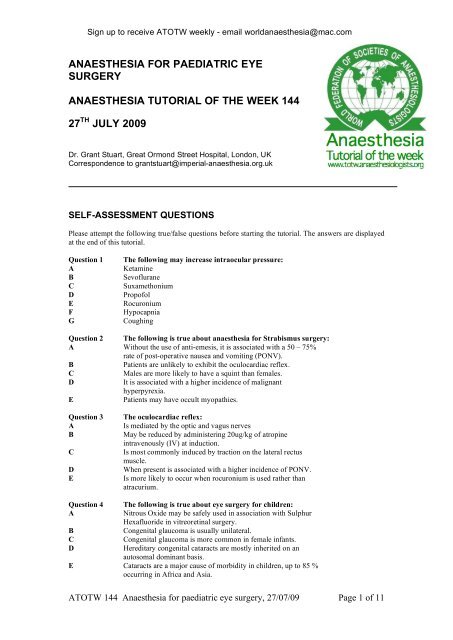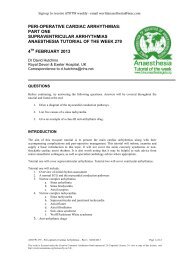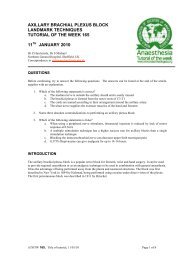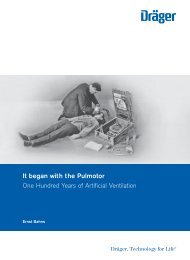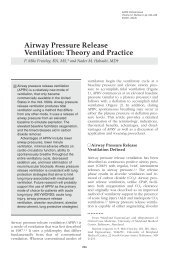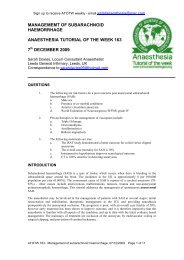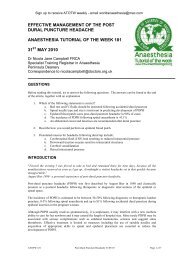144 Anaesthesia for paediatric eye surgery - Anaesthesia UK
144 Anaesthesia for paediatric eye surgery - Anaesthesia UK
144 Anaesthesia for paediatric eye surgery - Anaesthesia UK
Create successful ePaper yourself
Turn your PDF publications into a flip-book with our unique Google optimized e-Paper software.
Sign up to receive ATOTW weekly - email worldanaesthesia@mac.comANAESTHESIA FOR PAEDIATRIC EYESURGERYANAESTHESIA TUTORIAL OF THE WEEK <strong>144</strong>27 TH JULY 2009Dr. Grant Stuart, Great Ormond Street Hospital, London, <strong>UK</strong>Correspondence to grantstuart@imperial-anaesthesia.org.ukSELF-ASSESSMENT QUESTIONSPlease attempt the following true/false questions be<strong>for</strong>e starting the tutorial. The answers are displayedat the end of this tutorial.Question 1ABCDEFGThe following may increase intraocular pressure:KetamineSevofluraneSuxamethoniumPropofolRocuroniumHypocapniaCoughingQuestion 2 The following is true about anaesthesia <strong>for</strong> Strabismus <strong>surgery</strong>:A Without the use of anti-emesis, it is associated with a 50 – 75%rate of post-operative nausea and vomiting (PONV).BPatients are unlikely to exhibit the oculocardiac reflex.CMales are more likely to have a squint than females.DIt is associated with a higher incidence of malignanthyperpyrexia.EPatients may have occult myopathies.Question 3ABCDEThe oculocardiac reflex:Is mediated by the optic and vagus nervesMay be reduced by administering 20ug/kg of atropineintravenously (IV) at induction.Is most commonly induced by traction on the lateral rectusmuscle.When present is associated with a higher incidence of PONV.Is more likely to occur when rocuronium is used rather thanatracurium.Question 4ABCDThe following is true about <strong>eye</strong> <strong>surgery</strong> <strong>for</strong> children:Nitrous Oxide may be safely used in association with SulphurHexafluoride in vitreoretinal <strong>surgery</strong>.Congenital glaucoma is usually unilateral.Congenital glaucoma is more common in female infants.Hereditary congenital cataracts are mostly inherited on anautosomal dominant basis.E Cataracts are a major cause of morbidity in children, up to 85 %occurring in Africa and Asia.ATOTW <strong>144</strong> <strong>Anaesthesia</strong> <strong>for</strong> <strong>paediatric</strong> <strong>eye</strong> <strong>surgery</strong>, 27/07/09 Page 1 of 11
Sign up to receive ATOTW weekly - email worldanaesthesia@mac.comIntroductionUnlike adults, children requiring <strong>eye</strong> <strong>surgery</strong> do not tolerate the use of sedation and local anaesthetictechniques and there<strong>for</strong>e almost always require general anaesthesia. This tutorial will present a generalreview of the principles of anaesthesia <strong>for</strong> children undergoing <strong>eye</strong> <strong>surgery</strong> and a description ofanaesthesia <strong>for</strong> some specific procedures.General Principles of anaesthesia <strong>for</strong> Paediatric Eye SurgeryPreoperative considerationsMost children presenting <strong>for</strong> <strong>eye</strong> <strong>surgery</strong> are healthy, ASA I or II and may be managed as day cases. Avery small number may have underlying conditions, often of a chromosomal or metabolic nature,which pose more specific anaesthetic challenges (1,2). Examples of these are described in the tablebelow.Underlying condition Eye condition Special precautionsNeonates (cataracts) Congenital cataract As <strong>for</strong> neonatal <strong>surgery</strong> – warming,glucose management, monitoring <strong>for</strong>postoperative apnoeaCraniosynostosis syndromes(Crouzons, Aperts, Pfeiffer)Glaucoma, cataracts, squint,exopthalmosDifficult to maintain airway withfacemask (mid-face hypoplasia);improved by Guedel airway;intubation usually easyCraniofacial syndromes Glaucoma, cataracts, squint Micrognathia/facial asymmetry –(Goldenhar, Treacherdifficult intubationCollins, Smith-Lemli-Opitz)Mucopolysaccharidoses Corneal opacities, retinitis Difficult airway and intubation,(Hunter and Hurler’s pigmentosacardiomyopathy, cervical spinesyndromes)instabilityDown’s Syndrome, Edward’s Cataracts, strabismus Difficult intubation, cervical spineSyndrome, Cri du Chatinstability in Down’ssyndromeHallerman-Strieff syndrome Congenital cataract Difficult intubationStickler syndrome Glaucoma, Chorioretinoid Cleft palate and associated airwaydegeneration, lens dislocation problemsHomocystinuria Lens disclocation HypoglycaemiaMarfans’s syndrome Lens dislocation Aortic root dilatation, aortic/mitralvalve regurgitationNeuro-oculo-cutaneousdisorders (NeurofibromatosisSturge Weber syndrome,tuberous sclerosis, Von-Hippel-Lindau syndromeRetinal vascular disordersSeizures, intracranial lesions, cardiaclesions and phaeochromocytomaOphthalmic medicationsMany children requiring <strong>eye</strong> <strong>surgery</strong> will be taking or will subsequently receive <strong>eye</strong> drops. A basicknowledge of commonly used preparations and their potential effects is useful. There is a theoreticalrisk that these medications could be absorbed through the pharyngeal mucosa via the nasolacrimalducts, causing systemic effects, although it is unusual that this causes a significant problem (2,3,4).ATOTW <strong>144</strong> <strong>Anaesthesia</strong> <strong>for</strong> <strong>paediatric</strong> <strong>eye</strong> <strong>surgery</strong>, 27/07/09 Page 2 of 11
Sign up to receive ATOTW weekly - email worldanaesthesia@mac.comEye preparations Indication Systemic side effectBeta-blockers:Glaucoma Bradycardia refractory toTimolol maleate or Betaxololatropine; bronchospasm inhydrochloride)asthmaticsCarbonic anhydrase inhibitors: GlaucomaMetabolic acidosis, electrolyteAcetazolamide (diamox)abnormalities, allergies,including Stevens-JohnsonsyndromeAntimuscarinic agents: Pupil dilatationDry mucous membranes, nauseaCyclopentolate or AtropineAlpha-adrenergicsympathomimetic agents:9Phenylephrine 2.5%)NSAIDS:Diclofenac sodium, Ketorolactrometamol 0.5%Local anaesthetic agents:Amethocaine (Tetracaine),Oxybuprocaine, ProxymetacainePupil dilatationand vomiting, tachycardiaHypertension, tachycardiaPain relief Potential to worsen orprecipitate acute asthmaPain relief or prevention Local anaesthetic toxicity,particularly preterm neonatesAnaesthetic considerationsPre-medication, induction of anaesthesiaThe decision to pre-medicate the child and the choice of induction technique (intravenous orinhalational) should be tailored both to the needs of the child and to the preferences of the anaesthetist.It should be remembered that where the child has poor vision, they should be approached and handledin a careful and sensitive manner.Airway managementAirway management should be tailored to the procedure. For measurement of intraocular pressure(IOP), maintenance of spontaneous respiration via a facemask should be used, as intubation will raisethe intraocular pressure. For simple procedures such as examination under anaesthesia (EUA) someanaesthetists might find it more convenient to maintain spontaneous respiration through a rein<strong>for</strong>cedlaryngeal mask airway (LMA), particularly where a sterile field is required.The rein<strong>for</strong>ced LMA may be used in older children <strong>for</strong> most <strong>eye</strong> procedures. It has the advantages ofreduced coughing at the end of the <strong>surgery</strong> and controlled ventilation with the use of muscle relaxantsis possible.Intraocular <strong>surgery</strong> requires a still <strong>eye</strong> with low intraocular pressure and the airway is best managed byintubation with paralysis and controlled ventilation. Similarly, <strong>eye</strong> <strong>surgery</strong> in very young children isbest managed with intubation and controlled ventilation to ensure a secure airway. Access to the airwaywill be restricted during the <strong>surgery</strong> so it is important to secure the tracheal tube firmly. A pre<strong>for</strong>medsouth facing RAE tube is ideal, but this may be too long in neonates; a rein<strong>for</strong>ced flexible tracheal tube(ETT) may be preferable in this situation.Maintenance of anaesthesiaAs with induction, the choice of maintenance technique rests largely on the preferences of theanaesthetist and the availability of different agents.Where halothane is used there is an increased risk of dysrhythmias, particularly where <strong>eye</strong> preparationscontaining atropine or adrenaline are used, and in the presence of hypercapnia. Isoflurane orsevoflurane may be preferable.ATOTW <strong>144</strong> <strong>Anaesthesia</strong> <strong>for</strong> <strong>paediatric</strong> <strong>eye</strong> <strong>surgery</strong>, 27/07/09 Page 3 of 11
Sign up to receive ATOTW weekly - email worldanaesthesia@mac.comTotal intravenous anaesthesia (TIVA) with propofol has advantages in reducing the risk ofpostoperative nausea and vomiting (PONV) since propofol has anti-emetic effects. Remifentanil canreduce volatile requirements (5,6).The use of nitrous oxide in <strong>eye</strong> <strong>surgery</strong> is limited by two factors. Firstly nitrous oxide is known toincrease the risk of PONV, and in ophthalmic procedures there is a high incidence of PONV, so mostanaesthetists will tend to avoid its use. Secondly, nitrous oxide diffuses from the blood into gas filledspaces in the body. It should be avoided in vitreoretinal detachment <strong>surgery</strong> where intraocular gasbubbles of sulphur hexachloride or perfluropropane are introduced into the <strong>eye</strong> to tamponade detachedsurfaces. If nitrous oxide is used <strong>for</strong> a patient who has had recent vitreoretinal <strong>surgery</strong> (the bubble maylast several weeks), or if it is commenced mid procedure, it can cause a significant rise in intraocularpressure with resultant ischaemic damage. Alternatively, if nitrous oxide was used from the start of theanaesthetic, prior to placement of the gas bubble, it will diffuse out of the bubble on completion of theanaesthetic, and the bubble will shrink and risk re-detachment.Anaesthetic agents and intraocular pressureNormal intraocular pressure (IOP) ranges from 10 – 20 mmHg. Most anaesthetic agents will decreasethis. The table below describes the effects of commonly used anaesthetic agents on IOP. If serialmeasurements of IOP are being made, it is important to be consistent with the type of anaesthetic usedon different occasions (see below) (1,2,7-12).Anaesthetic agentPropofol, thiopentoneHalothane, sevoflurane, isoflurane, desfluraneOpioidsKetamineAtropineNon-depolarising muscle relaxantsSuxamethoniumAcetazolamide, mannitol, dextransEffect on intraocular pressureIOP reduced by 20-30% (3-7 mmHg)IOP reduced by 20-30% (3-7 mmHg)Minimal to no effect on IOPMinor dose dependent increase in IOP; markedeffect when dose exceeds 5mg/kgNo effect on IOPMinimal to no effect on IOPSignificant increase in IOP within 30secs ofadministration (approx 8mmHg), effect lasts <strong>for</strong>5-7 minutes, less if given with agents that reduceIOPUsed <strong>for</strong> acute reduction of IOP perioperativelyAnaesthetic techniques and intraocular pressurePhysical and physiological variables have an important effect on IOP.Laryngoscopy, coughing, straining, crying, bucking and the process of tracheal extubation may allcause a rise in IOP. This effect may be attenuated by a dose of lidocaine 1 mg/kg 3 minutes prior tointubation or extubation. Use of the LMA allows smoother induction and emergence from anaesthesiaand has much less effect on IOP (13,14,15).Hypoxia and hypercapnia both increase IOP.Hypocapnia and hypothermia decrease IOP.The Oculocardiac ReflexThe oculocardiac reflex is frequently encountered during <strong>eye</strong> <strong>surgery</strong> in children and is seen in up to60% of children undergoing strabismus <strong>surgery</strong>. It is there<strong>for</strong>e essential to use continuous heart ratemonitoring with an ECG during <strong>eye</strong> <strong>surgery</strong> in children. The reflex takes its afferent innervations fromthe ophthalmic division of the trigeminal nerve, relays via the sensory nucleus in the 4 th ventricle, withthe efferent impulse in the vagus nerve (1,2).ATOTW <strong>144</strong> <strong>Anaesthesia</strong> <strong>for</strong> <strong>paediatric</strong> <strong>eye</strong> <strong>surgery</strong>, 27/07/09 Page 4 of 11
Sign up to receive ATOTW weekly - email worldanaesthesia@mac.comSurgical traction on the extra-ocular <strong>eye</strong> muscles or pressure on the globe causes a sinus bradycardia,and occasionally junctional rhythms, atrioventricular block, atrial ectopics or ventricular ectopics. Thereflex is most commonly induced by traction on the medial rectus muscle, rather than the smallerlateral rectus muscle. The bradycardia resolves almost immediately after the stimulus has beenremoved and weakens with repetition of the stimulus.Intravenous atropine 20mcg/kg or glycopyrrolate 10mcg/kg at induction of anaesthesia will block theoculocardiac reflex. If not given at induction, it is important to have the drugs drawn up and ready toadminister if bradycardia should occur.The reflex may be attenuated by application of topical local anaesthetic agents to the <strong>eye</strong> (such astetracaine <strong>eye</strong> drops), or by blocking the afferent limb of the reflex with a peribulbar block, althoughthis block is not usually used in children due to the risk of globe per<strong>for</strong>ation (16,17).Sevoflurane is less likely to provoke the reflex than halothane, it is also less likely with deepanaesthesia compared to light anaesthesia. The incidence of significant bradycardia is doubled if thecarbon dioxide level is high, so controlled ventilation should be considered. The oculocardiac reflex ismore likely to occur with rocuronium rather than atracurium (1,19).Children who exhibit the oculocardiac reflex are more likely to develop PONV (18) and should receivean antiemetic during anaesthesia.Extubation and emergence from anaesthesiaIt is important to avoid coughing and bucking on the tracheal tube at the end of <strong>surgery</strong>, particularly <strong>for</strong>those children who have undergone intraocular <strong>surgery</strong>. For this reason, many anaesthetists use alaryngeal mask airway <strong>for</strong> <strong>eye</strong> <strong>surgery</strong> <strong>for</strong> suitable patients. If the patient has been intubated, deepextubation has been the method of choice, but this is contraindicated <strong>for</strong> emergency <strong>surgery</strong> (fullstomach) or those in whom the airway management is difficult. These children can be extubated awakewith a dose of lidocaine 1mg/kg IV to reduce the effects of extubation on IOP.Principles of pain relief and postoperative careMost <strong>eye</strong> or orbital procedures result in only mild to moderate postoperative pain. This is well managedwith simple analgesics such as paracetamol, NSAIDS and topical local anaesthetic agents. These maybe given pre-emptively as oral preparations preoperatively or rectally/IV at induction.Squints, evisceration and vitreoretinal <strong>surgery</strong> cause more severe pain requiring stronger analgesia.Intraoperative analgesia should include paracetamol, a NSAID, intravenous fentanyl and topical localanaesthetic if possible. Multimodal analgesia should be continued into the postoperative period, withthe addition of codeine phosphate or tramadol, escalating to morphine if required. The use of opioidsincreases the risk of PONV and antiemetics are essential.PONV is extremely common after <strong>paediatric</strong> <strong>eye</strong> <strong>surgery</strong>, and <strong>for</strong> strabismus <strong>surgery</strong> can be as high as60% if no prophylaxis is given. A dose of ondansetron 0.15 mg/kg has been shown to significantlyreduce PONV, and combination therapy (ondansetron and dexamethasone 0.1-0.2mg/kg) goes evenfurther, reducing PONV to as low as 10% in strabismus <strong>surgery</strong>. It is wise to leave the IV cannula inplace postoperatively where PONV may be a problem so that further anti-emetics and IV fluids mightbe given (20,21,22).Where ketamine has been given, the likelihood of emergence phenomena should be considered and thechild should be recovered in a quiet area with minimal stimulation (12).Most <strong>paediatric</strong> <strong>eye</strong> procedures are treated as day cases and children can resume oral intake as early asthey feel like. Occasionally the high incidence of PONV results in an unplanned overnight admission.ATOTW <strong>144</strong> <strong>Anaesthesia</strong> <strong>for</strong> <strong>paediatric</strong> <strong>eye</strong> <strong>surgery</strong>, 27/07/09 Page 5 of 11
Sign up to receive ATOTW weekly - email worldanaesthesia@mac.comANAESTHESIA FOR SPECIFIC OPHTHALMIC CONDITIONS AND PROCEDURESEUA and measurement of IOPFor an examination of the <strong>eye</strong>s under anaesthesia, either an inhalational or intravenous inductiontechnique and airway maintenance with a facemask will suffice. It may be technically easier to place anLMA <strong>for</strong> a longer EUA.For measurement of IOP, it should be remembered that most anaesthetic agents decrease IOP, and thiscan potentially mask a high IOP and compromise care.Some anaesthetists advocate the use of ketamine as it does not drop IOP, and although it may slightlyraise IOP, this may be safer than having a falsely low reading. Ketamine is given as 1 – 2mg/kg IV, orwhere there is no IV access available, as 5 – 10 mg/kg IM. Ketamine increases secretions so mustalways be given with either atropine 20mcg/kg IV or glycopyrolate 10mcg/kg IV. It is essential tomaintain an open airway, but instrumentation of the airway is rarely required (1,11,12).An acceptable alternative technique to ketamine is to use inhalational induction with sevoflurane withthe ophthalmologist present, and to measure the IOP as soon as the child is still. The sevofluraneshould be kept at
Sign up to receive ATOTW weekly - email worldanaesthesia@mac.commyopathies and there is a threefold increase in the incidence of masseter spasm. Although unproven,there is anecdotal evidence of an increased association with malignant hyperpyrexia (2).Squint correction is achieved by lengthening (recession), shortening or tightening (resection) ortransposition of any of the four rectus and two oblique extra-ocular muscles, or combinations of any ofthe above.Surgeons may use <strong>for</strong>ced duction testing to distinguish a paretic muscle from one that has restrictedmotion. In minor strabismus <strong>surgery</strong>, botulinum toxin may be injected into the extra-ocular musclerequiring electromyelogram (EMG) control. In these cases muscle relaxants should be avoided (1).In older children an adjustable suture may be used that allows fine adjustments to be made 24 – 48hours postoperatively under topical local anaesthetic once the patient is awake.Anaesthetic considerations:• Induction technique, method of airway control and choice of ventilation according to thepreference of the anaesthetist.• Maintenance of anaesthesia is usually achieved with a volatile anaesthetic agent and air; theuse of total intravenous anaesthesia (TIVA) has been shown to reduce PONV.• Consider atropine 20mcg/kg IV or glycopyrolate 10mcg/kg IV as high incidence ofoculocardiac reflex.• PONV is common postoperatively, up to 50 – 75%. Giving two anti-emetic agents such asondansetron 0.1 mg/kg IV and dexamethasone 0.1-0.2 mg/kg IV can reduce this to 10%.(20,21,22).• Ideally extubate the child deeply.• Analgesia should include topical tetracaine or oxybuprocaine, NSAIDS such as ibuprofen ordiclofenac and paracetamol, unless contraindicated.• Intraoperative opioids should be avoided due to the high incidence of PONV, but wherenecessary, consider the use of fentanyl.• A peribulbar block is effective <strong>for</strong> analgesic requirements and reduces PONV, possibly byblocking the ophthalmic division of the trigeminal nerve that passes to the vomiting centre inthe medulla. The risk of globe per<strong>for</strong>ation in children makes most practitioners cautious of this(17).• A sub-Tenon block per<strong>for</strong>med intraoperatively by the surgeon can be very effective <strong>for</strong>analgesia.GlaucomaThe pressure within the <strong>eye</strong> is maintained through a balance between the production of aqueous humor,primarily by the ciliary body in the posterior chamber, and drainage via the trabecular network to thecanal of Schlem in the anterior chamber.In glaucoma the normal IOP of 10 – 20 mmHg becomes elevated such that capillary blood flow to theoptic nerve becomes reduced, compromising the function of the optic nerve. The causes of glaucomaare varied.• Primary Congenital glaucoma is caused by a failure of the development of the trabecularnetwork, reducing the drainage of aqueous humour. It is bilateral in 75% of cases and has aprevalence of 1:10000 births. There is a male to female ratio of 35%: 65% and it is seen morecommonly in children below the age of 3 years.• Secondary Glaucoma is usually caused by a blockage of existing drainage channels and thiscan be caused by infection, inflammation or trauma. It is also seen in some rare syndromessuch as Sturge – Weber Syndrome, Axenfeld Syndrome and in association with aniridia in20% of patients with Wilm’s tumour (2).Treatment may be medical or surgical. Medical treatment consists of drugs used to reduce IOP such asacetazolamide 15 – 30 mg/kg/day in 3 – 4 divided doses, which suppresses aqueous production. ItsATOTW <strong>144</strong> <strong>Anaesthesia</strong> <strong>for</strong> <strong>paediatric</strong> <strong>eye</strong> <strong>surgery</strong>, 27/07/09 Page 7 of 11
Sign up to receive ATOTW weekly - email worldanaesthesia@mac.comusefulness is limited since the causes of glaucoma are usually structural and related to drainage. AfterEUA and measurement of IOP, surgical treatments may vary.• Goniotomy involves visualising the anterior chamber with a gonioscope and making anincision into the trabecular meshwork to allow drainage.• Trabeculotomy involves the insertion of a fine probe into Schlem’s canal to create a newdrainage channel.• Trabeculectomy involves the creation of a new drainage channel from the anterior chamberinto sub-Tenon’s space where the aqueous is absorbed.• Cyclocryotherapy is the ablation of part of the ciliary body by a cryoprobe at – 60 to – 80 ˚C toreduce the production of aqueous humour (2).Anaesthetic considerations:• Avoid raising the IOP by ensuring a smooth induction and deep emergence without coughing.• Maintain a motionless <strong>eye</strong>; consider paralysis and controlled ventilation to avoid hypercapnia.• Analgesia with paracetamol and NSAIDS is usually adequate, however whencyclocryotherapy is used opioids may be necessary.• High incidence of PONV – routine anti-emetics.Cataract extractionCataracts are a major cause of childhood morbidity worldwide, predominantly in the developingcountries in Africa and Asia (85% of cases).Aetiology may be varied (2):• Hereditary cataracts are usually inherited via autosomal dominant patterns and present inotherwise healthy children.• Syndromes may be associated with cataracts. Some include Lowe’s oculo-cerebro-renalsyndrome (X-linked recessive), Down’s syndrome (Trisomy 21), Edward’s Syndrome andCri-du-chat syndrome.• Metabolic causes may include Glucose-6-phosphate dehydrogenase deficiency,hypoglycaemia, hypocalcaemia and galactosaemia.• Blunt or penetrating trauma usually results in unilateral cataracts.• Inflamation such as the uveitis associated with Juvenile chronic arthritis may cause cataracts.• Tumours, such as retinoblastoma.• Intrauterine infections, including Rubella, Cytomegalovirus (CMV), Toxoplasma andToxocariasis.• Radiation <strong>for</strong> leukaemia might cause cataracts.• Chronic steroid useTreatment involves surgical implantation of an intraocular lens, which may need to be done very early(as early as 4 weeks old) in order to allow stimulation of the retina and visual development. Theprocedure takes about 30 - 60 minutes, but complications can be more frequent than in adults andinclude uveitis, glaucoma, endophthalmitis, iris damage or prolapse, retinal detachment and thickeningof the posterior lens capsule (2).Anaesthetic considerations:• Aim <strong>for</strong> a motionless <strong>eye</strong> either with deep anaesthesia or a paralysed patient.• Avoid high IOP with a smooth induction and emergence.• Consider controlled ventilation to avoid hypercapnia.• Give anti-emetics.Enucleation and eviscerationEnucleation is the removal of the whole <strong>eye</strong>. This may be done <strong>for</strong> surgical treatment of aretinoblastoma, significant <strong>eye</strong> trauma or <strong>for</strong> cosmetic reasons where an <strong>eye</strong> is blind. It involves thedissection of the extra-ocular muscles off the globe. Anaesthetists should be aware that there is similarATOTW <strong>144</strong> <strong>Anaesthesia</strong> <strong>for</strong> <strong>paediatric</strong> <strong>eye</strong> <strong>surgery</strong>, 27/07/09 Page 8 of 11
Sign up to receive ATOTW weekly - email worldanaesthesia@mac.comrisk here <strong>for</strong> the oculocardiac reflex, although less risk of PONV, and should manage the case as <strong>for</strong>strabismus <strong>surgery</strong>.Evisceration involves the removal of the contents of the globe, but retention of the sclera. Thisprocedure is often painful and opioid use should be considered (1).Penetrating <strong>eye</strong> <strong>surgery</strong>A penetrating injury to the <strong>eye</strong> is a relatively common injury in children, primarily boys between 3 and9 years, and requires <strong>surgery</strong> to close the defect or remove a <strong>for</strong>eign body. Surgery is urgent asanything that raises IOP (coughing, straining) may cause the globe to extrude its contents (2,3).This presents two conflicting anaesthetic problems. Firstly, the child may have a full stomach so arapid sequence intubation with suxamethonium is indicated in order to prevent aspiration. Secondlythere is a need to protect the globe from a rise in IOP that could result in extrusion of the structures ofthe anterior chamber or the vitreous humor. The transient rise in intraocular pressure produced by theuse of suxamethonium could theoretically cause this (23).• One approach recommends the use of a large dose of non-depolarising muscle relaxant(NDMR) and ventilation with cricoid pressure until intubating condition is achieved,providing the child has a normal airway (10).• Another view is that there have been no documented reports of vitreous extrusion after the useof suxamethonium, and protection of the airway is paramount (24); hence the use ofsuxamethonium and a traditional rapid sequence induction is indicated.• The advent of suggamadex a drug that can rapidly reverse rocuronium (rapid onset, longacting muscle relaxant) may allow rapid sequence induction using rocuronium to be used asan alternative technique in the presence of a more challenging airway.Other considerations include:• Crying, coughing and straining should be avoided; consider light oral sedation and analgesiapreoperatively.• Direct larygnoscopy of a poorly paralysed airway can cause coughing and bucking, whichevertechnique is used.• Consider blunting the intubation response prior to laryngoscopy. Administer lidocaine 1 -2mg/kg IV given 3 minutes prior to rapid sequence intubation during preoxygenation• Consider monitoring the child with a nerve stimulator after adminstration of the musclerelaxant.Vitreoretinal <strong>surgery</strong>Vitreoretinal <strong>surgery</strong> is per<strong>for</strong>med <strong>for</strong> the repair of a detached retina, and although unusual, may benecessary in children. Detachment may be primary where it is related to a defect in the retina, orsecondary to an underlying illness. The <strong>surgery</strong> involves creating a choreoretinal scar with cryotherapyand placing a scleral buckle towards the back of the <strong>eye</strong>, which serves to oppose the neuroretina andretinal pigment epithelium. The surgeon may also place an intraocular bubble of either sulphurhexafluoride or perfluropropane to tamponade the detached surfaces together (1,2).Anaesthetic considerations:• Avoid nitrous oxide if an intraocular gas bubble is used.• Avoid nitrous oxide in patients who have had an intraocular bubble placed <strong>for</strong> several weeksafter the procedure. Parents should be given clear instructions in this regard <strong>for</strong> futureanaesthetics.• Controlled ventilation and paralysis should be considered <strong>for</strong> maintaining a still <strong>eye</strong> andavoiding raised IOP during the procedure.• This procedure is painful and analgesia including opioids should be considered.• Anti-emesis should be used routinely• Avoid raised IOP during extubation – extubate deep.ATOTW <strong>144</strong> <strong>Anaesthesia</strong> <strong>for</strong> <strong>paediatric</strong> <strong>eye</strong> <strong>surgery</strong>, 27/07/09 Page 9 of 11
Sign up to receive ATOTW weekly - email worldanaesthesia@mac.comCONCLUSIONThis tutorial has reviewed the general principles of anaesthesia <strong>for</strong> <strong>paediatric</strong> <strong>eye</strong> <strong>surgery</strong>, as well asconsiderations <strong>for</strong> some common procedures. Key learning points include:• Children require general anaesthesia <strong>for</strong> ophthalmic procedures and <strong>surgery</strong>, but most arehealthy and can be managed as day cases.• The oculocardiac reflex may be induced during <strong>eye</strong> <strong>surgery</strong> and risks produce dangerousbradycardias, which can be prevented by premedicating with anticholinergic agents.• Post operative nausea and vomiting is common after <strong>eye</strong> <strong>surgery</strong> in children and might delaydischarge if suitable prophylaxis is not given.SELF-ASSESSMENT ANSWERSQuestion 1A TB FC TD FE FF FG TQuestion 2A TB FC FD TE TQuestion 3A FB TC FD TE TQuestion 4A FB FC TD TE TREFERENCES1. James I, <strong>Anaesthesia</strong> <strong>for</strong> <strong>paediatric</strong> <strong>eye</strong> <strong>surgery</strong>. Continuing Education in <strong>Anaesthesia</strong>,Critical Care and Pain 2008 8: 5 – 102. Morrison A, Ophthalmology, plastics, oncology, radiology, thoracic, and dental <strong>surgery</strong>. In:Doyle E, eds. Paediatric <strong>Anaesthesia</strong>. Ox<strong>for</strong>d, Ox<strong>for</strong>d University Press. 2007; 298 – 307.3. Steward DJ, Lerman J. Manual of Pediatric Anesthesia. Churchill Livingstone, 2001; 225 –233.4. BNF <strong>for</strong> children. Notes on drugs and preparations: Eye. BMJ group, RPS Publishing. 2008,606 – 627.5. Reimer EJ, Montgomery CJ, JC Bevan, et al. Propofol anaesthesia reduces early postoperativeemesis after <strong>paediatric</strong> strabismus <strong>surgery</strong>. Canadian Journal of <strong>Anaesthesia</strong>. 1993; 40: 927 –933.6. Marsh DF, Hodkinson B. Remifentanil in <strong>paediatric</strong> anaesthetic practice. <strong>Anaesthesia</strong>. 200964: 301 – 308.7. Sator S, Wilding E, Schabering C, et al. Desflurane maintains intraocular pressure at anequivalent level to isoflurane and propofol during unstressed non-ophthalmic <strong>surgery</strong>, BritishJournal of <strong>Anaesthesia</strong>. 1998; 80: 243 -245.8. Sator – Katzenschlager S, Deusch E, Dolezal S, et al. Sevoflurane and propofol decreaseintraocular pressure equally during non-ophthalmic <strong>surgery</strong> and recovery. British Journal of<strong>Anaesthesia</strong>. 2002; 89: 764 – 767.9. Sator-Katzenschlager SM, Oehmke MJ, Deusch E, et al. Effects of remifentanil and fentanylon intraocular pressure during the maintenance and recovery of anaesthesia in patientsundergoing non-ophthalmic <strong>surgery</strong>. European Journal of Anaesthesiology. 2004; 21: 95 –101.10. Chiu CL, Jaais F, Wang CY, Effect of Rocuronium compared with succinylcholine onintraocular pressure during rapid sequence induction of anaesthesia. British Journal ofanaesthesia. 1999, 82: 757 - 761.ATOTW <strong>144</strong> <strong>Anaesthesia</strong> <strong>for</strong> <strong>paediatric</strong> <strong>eye</strong> <strong>surgery</strong>, 27/07/09 Page 10 of 11
Sign up to receive ATOTW weekly - email worldanaesthesia@mac.com11. Craven R. Ketamine. <strong>Anaesthesia</strong>. 2007; 62: 48 – 53.12. Pun MS, Thakur J, Poudyal G, et al. Ketamine anaesthesia <strong>for</strong> <strong>paediatric</strong> ophthalmology<strong>surgery</strong>. British Journal of Ophthalmology. 2002; 87: 535 – 538.13. Lerman J, Kiskis AA. Lidocaine attenuates the intraocular pressure response to rapidintubation in children. Canadian Anaesthetists’ Society Journal. 1985; 32: 339 – 345.14. Drenger B, Pe’er J. Attenuation of the ocular and systemic responses to tracheal intubation byintravenous lignocaine. British Journal of Ophthalmology. 1987; 71: 546 – 548.15. Gulati M, Mohta M, Ahuja S, et al. Comparison of Laryngeal Mask Airway with trachealTube <strong>for</strong> Ophthalmic Surgery in Paediatric patients. <strong>Anaesthesia</strong> and Intensive Care. 2004;32: 383 – 390.16. Ruta U, Mollhoff T, Markodimitrakis H, Brodner G. Attenuation of the oculocardiac reflexafter topically applied lignocaine during <strong>surgery</strong> <strong>for</strong> strabismus in children. European Journalof Anaesthesiology. 1996; 13: 11 – 15.17. Gupta N, Kumar R, Kumar S, et al. A prospective randomised double blind study to evaluatethe effect of peribulbar block or topical application of local anaesthesia combined with generalanaesthesia on intra-operative and postoperative complications during <strong>paediatric</strong> strabismus<strong>surgery</strong>. <strong>Anaesthesia</strong>. 2007 62: 1110 – 1113.18. Allen LE, Sudesh S, Sandramouli S, Cooper G, et al. The association between theoculocardiac reflex and postoperative vomiting in children undergoing strabismus <strong>surgery</strong>.Eye. 1998; 12: 193 – 196.19. Yi C, Jee D. Influence of the anaesthetic depth on the inhibition of the oculocardiac reflexduring sevoflurane anaesthesia <strong>for</strong> <strong>paediatric</strong> strabismus <strong>surgery</strong>. British Journal of<strong>Anaesthesia</strong>. 2008; 101: 234 – 234.20. Rose JB, Martin TM, Corddry DH, et al. Ondansetron reduces the incidence and severity ofpost strabismus repair vomiting in children. <strong>Anaesthesia</strong> and Analgesia. 1994; 79: 486 – 489.21. Sennaraj B, Shende D, Sadhasivam S, et al. Management of post-strabismus nausea andvomiting in children using ondansetron: a value-based comparison of outcomes. BritishJournal of <strong>Anaesthesia</strong>. 2002; 89: 473 – 478.22. Tramer M, Moore A, McQuay H. Prevention of vomiting after <strong>paediatric</strong> strabismus <strong>surgery</strong>:a systematic review using numbers-needed-to-treat method. British Journal of <strong>Anaesthesia</strong>.1995; 75: 556 – 561.23. Murphy DF, <strong>Anaesthesia</strong> and Intraocular pressure. <strong>Anaesthesia</strong> and Analgesia. 1985; 64: 520– 530.24. Vachon CA, Warner DO, Bacon DR. Succinylcholine and the open globe: tracing theteaching. Anaesthesiology. 2003; 99: 220 – 223.ATOTW <strong>144</strong> <strong>Anaesthesia</strong> <strong>for</strong> <strong>paediatric</strong> <strong>eye</strong> <strong>surgery</strong>, 27/07/09 Page 11 of 11


